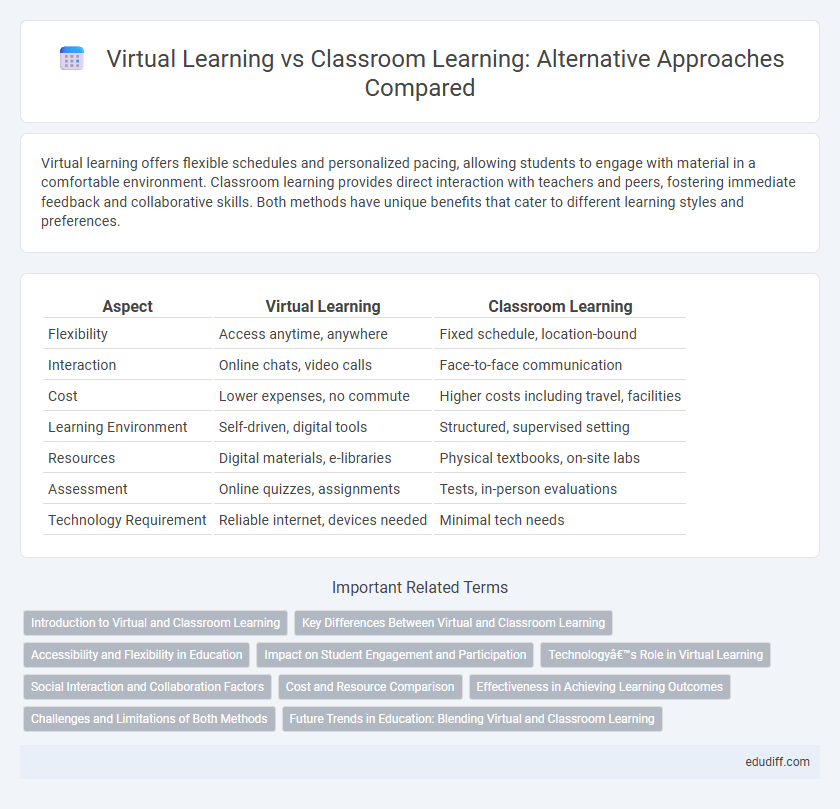Virtual learning offers flexible schedules and personalized pacing, allowing students to engage with material in a comfortable environment. Classroom learning provides direct interaction with teachers and peers, fostering immediate feedback and collaborative skills. Both methods have unique benefits that cater to different learning styles and preferences.
Table of Comparison
| Aspect | Virtual Learning | Classroom Learning |
|---|---|---|
| Flexibility | Access anytime, anywhere | Fixed schedule, location-bound |
| Interaction | Online chats, video calls | Face-to-face communication |
| Cost | Lower expenses, no commute | Higher costs including travel, facilities |
| Learning Environment | Self-driven, digital tools | Structured, supervised setting |
| Resources | Digital materials, e-libraries | Physical textbooks, on-site labs |
| Assessment | Online quizzes, assignments | Tests, in-person evaluations |
| Technology Requirement | Reliable internet, devices needed | Minimal tech needs |
Introduction to Virtual and Classroom Learning
Virtual learning offers flexible access to educational resources through digital platforms, enabling students to study anytime and anywhere. Classroom learning provides structured, face-to-face interaction between teachers and students, facilitating immediate feedback and social engagement. Both methods incorporate essential instructional strategies but differ significantly in delivery, accessibility, and interaction.
Key Differences Between Virtual and Classroom Learning
Virtual learning offers flexibility and accessibility by allowing students to access course materials anytime and anywhere, contrasting with classroom learning's fixed schedules and physical presence. Interaction in classroom learning is immediate and personal, fostering real-time collaboration, while virtual learning relies heavily on digital communication tools that may delay feedback. Assessment methods also differ, with classroom environments often utilizing in-person exams and virtual learning emphasizing online quizzes and project-based evaluations.
Accessibility and Flexibility in Education
Virtual learning provides unparalleled accessibility by allowing students to access educational materials anytime and anywhere, eliminating geographical and physical barriers. Classroom learning offers structured schedules that can benefit those who thrive in face-to-face interaction but may lack the flexibility needed for diverse lifestyles. The flexibility of virtual education supports personalized learning paces, making it ideal for learners balancing work, family, or other commitments.
Impact on Student Engagement and Participation
Virtual learning platforms offer interactive tools such as polls, quizzes, and breakout rooms, enhancing student engagement by catering to diverse learning styles and increasing participation opportunities. Classroom learning fosters direct face-to-face interaction and immediate feedback, which can boost motivation and active involvement through social cues and peer collaboration. Studies show hybrid models combining virtual and in-person methods often lead to higher engagement and participation rates compared to exclusively virtual or traditional classroom settings.
Technology’s Role in Virtual Learning
Technology plays a pivotal role in virtual learning by enabling interactive platforms, real-time communication, and access to diverse educational resources globally. Advanced tools such as AI-driven personalized learning systems and virtual reality simulations enhance student engagement and accommodate varied learning styles. The integration of cloud computing and high-speed internet ensures seamless content delivery and collaboration, bridging gaps between instructors and learners in remote environments.
Social Interaction and Collaboration Factors
Virtual learning enables students to engage in collaborative projects through digital platforms, fostering global connections and flexible communication. Classroom learning offers direct face-to-face interaction, enhancing non-verbal cues and immediate feedback essential for effective teamwork. Social interaction in physical classrooms promotes stronger peer relationships and spontaneous group discussions that enrich collaborative experiences.
Cost and Resource Comparison
Virtual learning significantly reduces costs by eliminating expenses related to physical infrastructure, commuting, and printed materials, making it a cost-effective alternative to traditional classroom education. Classroom learning often requires substantial investment in facilities, utilities, and maintenance, increasing the overall financial burden on institutions and students. Resource-wise, virtual platforms provide scalable access to digital tools and multimedia content, whereas classroom settings depend heavily on physical resources and limited time-bound interactions.
Effectiveness in Achieving Learning Outcomes
Virtual learning leverages interactive multimedia tools and flexible pacing, resulting in comparable or higher achievement of learning outcomes compared to traditional classroom settings. Studies indicate that virtual environments enhance retention rates by catering to diverse learning styles and providing immediate feedback through adaptive technologies. However, classroom learning fosters direct social interaction and hands-on experiences, which are critical for developing collaborative skills and practical competencies.
Challenges and Limitations of Both Methods
Virtual learning often faces challenges such as technical issues, limited social interaction, and difficulties in maintaining student engagement, which can hinder effective knowledge retention. Classroom learning encounters limitations including fixed schedules, geographical constraints, and varied teaching quality, impacting accessibility and consistency. Both methods require adapting strategies to address issues like digital divide in virtual settings and resource constraints in traditional classrooms.
Future Trends in Education: Blending Virtual and Classroom Learning
Future trends in education emphasize the integration of virtual learning and classroom learning to create a hybrid model that enhances accessibility and personalized instruction. Emerging technologies like AI-driven platforms and augmented reality are revolutionizing interactive experiences, promoting deeper engagement in both physical and virtual settings. This blended approach supports flexible scheduling, diverse learning styles, and scalable collaboration, positioning education for greater adaptability in a rapidly evolving digital landscape.
Virtual Learning vs Classroom Learning Infographic

 edudiff.com
edudiff.com